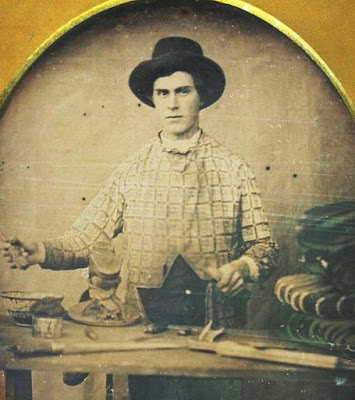A pair of plaid shoes from France, Cora Ginsberg's archives
Plaids? No Problem.
It's identifying the source of woven plaids that is a problem.
Woven and printed plaids and stripes in a quilt from about 1900
The problem is with the plaids dyed in the yarn and then
woven into patterns.
A few friends got together last spring to look at a lot of 19th-century plaid quilts, hoping to determine clues that could help us date quilts, assign a region or a time period to them and determine if the fabrics were factory made or as people like to say homespun----we mean home woven.
We enjoyed ourselves no end but we didn't come up with many answers to our questions.
A generalization: We see four kinds of plaids in American quilts.
1. Woven plaids of different fibers in warp and weft---for example wool warp, cotton weft.
It looks like moths have eaten the blue wool yarns leaving
the white cotton yarns in this piece of linsey-woolsey, a mixed fiber.
These are difficult to date (other than pre 1900) and to classify by
region since they might be home woven or factory woven.
2. Printed Plaids
As in Catherine's block for this 1848 album quilt.
Shoemaker in a printed plaid shirt
Printed plaids were quite fashionable in the 1840s and again in the 1940s. Pattern was applied with cylinder or roller printing in a factory, a style of what was called "calico printing".
Two diagonal printed plaids from the 1870-1900 years.
I've heard diagonal plaids called a "printer's joke." You cannot weave a diagonal plaid.
Printed plaids are factory produced. The 19th-century factories that turned out so many of these tended to be in New England and England.
2. Woven plaids with a high thread count/cotton warp and weft.
Could have been woven in 1790 or 1990,
anywhere in the world.
The patchwork and adjacent prints in both these quilt details indicate
1830-1870.
You can get this look by cutting up today's shirts.
Plaids woven of fine yarns are so common that they give us no indication of regionalism and no clues to date.
3. Woven plaids of cotton warps and wefts but coarser yarns.
The prints and quilt style indicate a date of about 1890-1920.
The coarse plaids are also no help at all in dating.
Here we have no prints to help us date this quilt. But there
is a style clue. Quilts of many woven plaids, stripes and checks, like
these were popular about 1900-1925...
Whether the fabrics were woven of coarse or fine yarns.
So we do get clues to date, but mainly from the style not the individual plaids.
Quilt #1
When we see one of these quilts (or comforters) pieced of wovens
we can guess early 20th century.
Quilt #2
Quilt # 3
Quilt #4
Quilt #5
But can the style tell us where the quilt was made or where the fabric was woven?
Fabric A
Fabric B
Fabric C
Fabric D
I'll tell you where these quilts and swatches are from tomorrow.























I like plaids, they look fine in utility or in formal use.
ReplyDeleteI'm staying tuned for more.
All I know is, I want those plaid shoes!!
ReplyDeleteWendy. Magic markers.
ReplyDelete